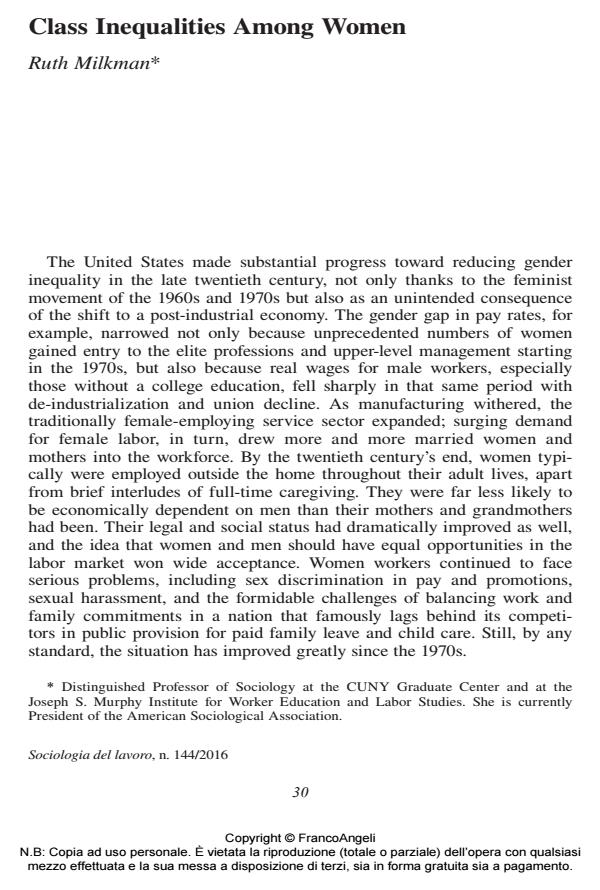Class Inequalities Among Women
Journal title SOCIOLOGIA DEL LAVORO
Author/s Ruth Milkman
Publishing Year 2016 Issue 2016/144
Language English Pages 7 P. 30-36 File size 79 KB
DOI 10.3280/SL2016-144003
DOI is like a bar code for intellectual property: to have more infomation
click here
Below, you can see the article first page
If you want to buy this article in PDF format, you can do it, following the instructions to buy download credits

FrancoAngeli is member of Publishers International Linking Association, Inc (PILA), a not-for-profit association which run the CrossRef service enabling links to and from online scholarly content.
Since the 1970s, gender inequalities have declined dramatically in the USA, but in the same period, class inequalities rapidly widened, with profound implications for both women and men. This article documents the fact that class inequalities among women in the 21st century USA are greater than ever before. Job segregation by gender declined in elite jobs but remained unchanged in working-class jobs. And endogamous marriage and mating further multiplied inequalities among women. Although public concern about class inequality has surged in recent years, the rapid rise in within-group’ inequalities among women has received far less attention.
Keywords: Gender, class, inequality, women, endogamy
- Wilson W.J. (1980). The Declining Significance of Race: Blacks and Changing American Institutions. Chicago: University of Chicago Press.
- Blau F.D., Brummund P., Yung-Hsu Liu A. (2013). Trends in Occupational Segregation by Gender 1970-2009: Adjusting for the Impact of Changes in the Occupational Coding System. Demography, 50, n. 2: 471-492.
- Burtless G. (1999). Effects of Growing Wage Disparities and Changing Family Composition on the U.S. Income Distribution. European Economic Review, 43: 853-865.
- Carbone J., Chan N. (2014). Marriage Markets: How Inequality is Remaking the American Family. New York: Oxford University Press.
- Cotter D.A., Hermsen J.M., Vanneman R. (2004). Gender Inequality at Work. The American People: Census 2000. New York: Russell Sate Foundation and Washington, D.C.: Population Reference Bureau.
- Damaske S. (2011). For the Family? How Class and Gender Shape Women’s Work. New York: Oxford University Press.
- England P. (2010). The Gender Revolution: Uneven and Stalled. Gender & Society, 24, n. 2: 149-166.
- Gross E. (1968). Plus Ca Change… The Sexual Structure of Occupations over Time. Social Problems, 16, n. 2: 198-208.
- Hays S. (1996). The Cultural Contradictions of Motherhood. New Haven: Yale University Press.
- Hegewisch A., Liepmann H., Hayes J., Hartmann H. (2010). Separate and Not Equal? Gender Segregation in the Labor Market and the Gender Wage Gap. Briefing Paper, C377, Washington, D.C.: Institute for Women’s Policy Research.
- Institute for Women’s Policy Research (2014). The Gender Wage Gap: 2013, Fact Sheet C413, March.
- Jacobs J.A., Gerson K. (2004). The Time Divide: Work, Family and Gender Inequality. Cambridge: Harvard University Press.
- Lareau A. (2003). Unequal Childhoods: Class, Race, and Family Life. Berkeley: University of California Press.
- Lareau A. (2015). An hereditary meritocracy. The Economist, Jan. 24-30: 17-20.
- McCall L. (2008). What Does Class Inequality among Women Look Like? A Comparison with Men and Families, 1970 to 2000. In Lareau A., Conley D., eds., Social Class: How Does it Work?. New York: Russell Sage Foundation.
- Milkman R. (1987). Gender at Work: The Dynamics of Job Segregation by Sex during World War II. Urbana: University of Illinois Press.
- Milkman R., Appelbaum E. (2013). Unfinished Business: Paid Family Leave in California and the Future of U.S. Work-Family Policy. Ithaca: Cornell University Press.
- Sandberg S. (2013). Lean In: Women, Work and the Will to Lead. New York: Knopf.
Ruth Milkman, Class Inequalities Among Women in "SOCIOLOGIA DEL LAVORO " 144/2016, pp 30-36, DOI: 10.3280/SL2016-144003